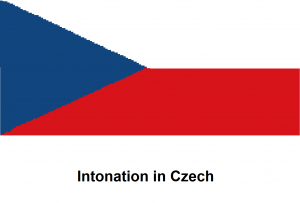Language/Czech/Pronunciation/Intonation
Hello Everyone, 😊
In today’s lesson we are going to study the following topic: ”INTONATION” in Czech
Please feel free to edit this page if you think it can be improved!
Happy learning!
Learners will find it easiest to acquire intonation patterns by listening to the language as spoken by native speakers, and there are also regional variants.
However, a few extremely basic points may help, and you might try asking a native speaker to perform the examples below, along with some other similar sentences.
Statements have a basically falling (klesavá) intonation, preceded by a possible short rise on an emphasised word near the end. Notice also how Czech sentences like to start with known information and put key words of fresh information later. English relies on the intonation more fully for supplying any required emphasis, while Czech is able to adjust the word order with greater freedom:
01) Petr je tady. Je tady Petr. Petr is here.
01) Petr je tady. Je tady Petr. Petr is here. Petr is here.
Questions opening with question words have a similar falling pattern to plain statements, again with a short rise on a key word near the end. The question word itself makes it clear that this is a question, so no special pattern is required:
02) Kde je Petr? Where is Petr?
02) An exclamation will produce a greater rise on a key word near the end:
Petr je tady! Je tady Petr! Petr is here! Petr is here!
Questions without a question word will have either a type of rising (stoupavá) intonation, or, rather more distinctively (especially in Prague and Bohemia), a characteristic low-to-high rising and then falling (stoupavb klesavá) pattern or cadence across the final key word or phrase:
03) Je tady Petr? Je Petr tady?/ Is Petr here? Is Petr here?
03) Petr je tady?
The question intonation patterns indicate incompleteness – the reply should complete the whole by supplying the requested answer. Similarly, non-final clauses in a sentence will also have a (less prominent) form of rising intonation (e.g. preceding a comma which marks a pause), likewise indicating incompleteness:
Petr je tady, ale Jana je doma. Petr is here, but Jana is at home.
Take some time to dive into these other pages after completing this lesson: Alphabet and Pronunciation, Months of the Year.
Source[edit | edit source]
http://utkl.ff.cuni.cz/~rosen/public/GGG/Czech_essent_grammar.pdf
Other Lessons[edit | edit source]

